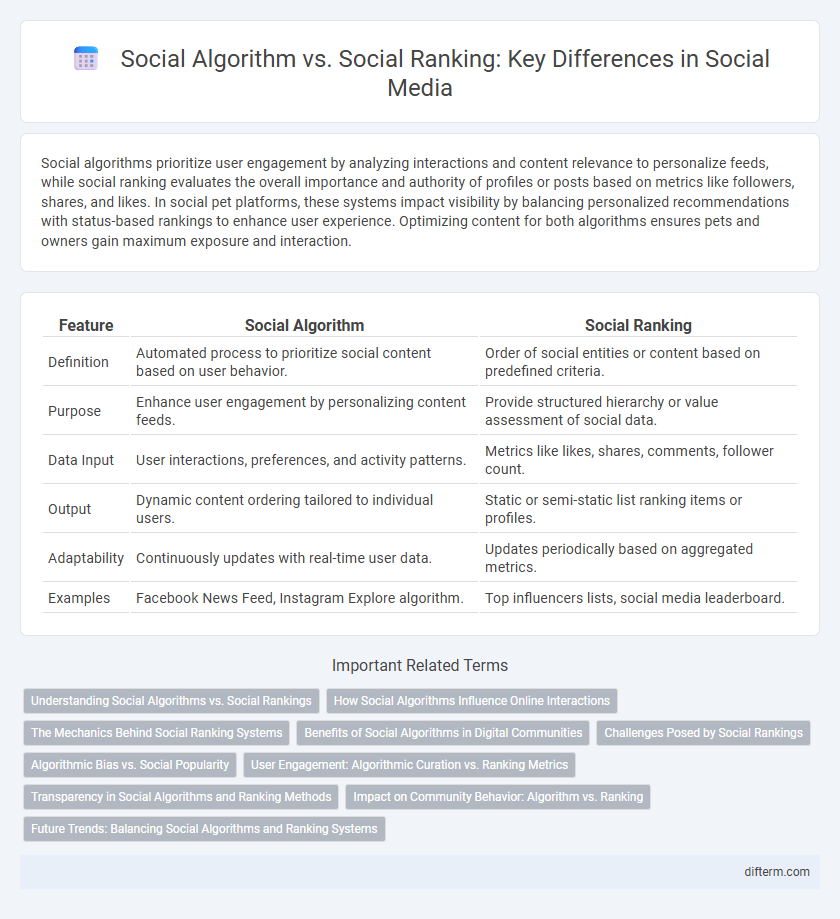Social algorithms prioritize user engagement by analyzing interactions and content relevance to personalize feeds, while social ranking evaluates the overall importance and authority of profiles or posts based on metrics like followers, shares, and likes. In social pet platforms, these systems impact visibility by balancing personalized recommendations with status-based rankings to enhance user experience. Optimizing content for both algorithms ensures pets and owners gain maximum exposure and interaction.
Table of Comparison
| Feature | Social Algorithm | Social Ranking |
|---|---|---|
| Definition | Automated process to prioritize social content based on user behavior. | Order of social entities or content based on predefined criteria. |
| Purpose | Enhance user engagement by personalizing content feeds. | Provide structured hierarchy or value assessment of social data. |
| Data Input | User interactions, preferences, and activity patterns. | Metrics like likes, shares, comments, follower count. |
| Output | Dynamic content ordering tailored to individual users. | Static or semi-static list ranking items or profiles. |
| Adaptability | Continuously updates with real-time user data. | Updates periodically based on aggregated metrics. |
| Examples | Facebook News Feed, Instagram Explore algorithm. | Top influencers lists, social media leaderboard. |
Understanding Social Algorithms vs. Social Rankings
Social algorithms analyze user behavior, preferences, and engagement patterns to personalize content delivery, enhancing relevance and user experience on platforms like Facebook and Instagram. Social rankings, on the other hand, prioritize content based on popularity metrics such as likes, shares, and comments, determining content visibility and influence within networks. Understanding the distinction between these systems helps marketers optimize strategies for improved reach and engagement in social media ecosystems.
How Social Algorithms Influence Online Interactions
Social algorithms shape online interactions by curating content based on user behavior, preferences, and engagement patterns, leading to personalized feeds that increase user activity. These algorithms prioritize posts that generate higher engagement, influencing visibility and social ranking within platforms like Facebook, Instagram, and Twitter. As a result, social ranking systems reflect algorithm-driven popularity metrics, reinforcing user influence and shaping online communities dynamically.
The Mechanics Behind Social Ranking Systems
Social ranking systems leverage complex algorithms that analyze user interactions, content relevance, and engagement metrics to determine the visibility of posts and profiles. These algorithms process large volumes of data, including likes, shares, comments, and click-through rates, to rank content based on perceived value and user preferences. Machine learning models continuously refine these rankings, optimizing content delivery to maximize user retention and platform activity.
Benefits of Social Algorithms in Digital Communities
Social algorithms enhance digital communities by personalizing content feeds, increasing user engagement, and fostering relevant interactions. They analyze user behavior and preferences to deliver tailored experiences, which boosts retention and satisfaction. Efficient social algorithms also help identify and reduce harmful content, promoting a safer and more respectful online environment.
Challenges Posed by Social Rankings
Social rankings often prioritize content based on popularity metrics, creating challenges such as echo chambers and reduced content diversity. Algorithms designed for social platforms may inadvertently amplify biases, leading to unfair visibility and marginalization of less mainstream voices. These ranking systems can distort user perception by promoting sensationalist content, undermining the quality of social interactions and information dissemination.
Algorithmic Bias vs. Social Popularity
Social algorithms often prioritize engagement metrics, inadvertently reinforcing algorithmic bias by amplifying content from dominant groups while marginalizing minority voices. Social ranking, driven by social popularity, tends to reflect collective approval but can perpetuate echo chambers and popularity contests rather than diverse perspectives. Understanding the interplay between algorithmic bias and social popularity is crucial for creating equitable social platforms that foster inclusivity and balanced representation.
User Engagement: Algorithmic Curation vs. Ranking Metrics
Social algorithms prioritize user engagement by curating content tailored to individual preferences through machine learning models that analyze behavior patterns, clicks, and interactions. In contrast, social ranking systems emphasize quantifiable ranking metrics such as likes, shares, and comments to order content visibility, often favoring highly popular posts. Algorithmic curation fosters personalized experiences by dynamically adapting feeds, while ranking metrics create a competitive content environment driven by measurable user signals.
Transparency in Social Algorithms and Ranking Methods
Transparency in social algorithms and ranking methods is crucial for fostering user trust and ensuring fairness in content visibility. Detailed disclosures about algorithmic criteria and ranking factors enable users to understand how their data influences content prioritization, mitigating biases and promoting accountability. Clear transparency protocols also facilitate regulatory compliance and empower users to make informed decisions about their social media interactions.
Impact on Community Behavior: Algorithm vs. Ranking
Social algorithms shape community behavior by curating content based on engagement patterns, fostering personalized user experiences and reinforcing existing preferences. Social ranking systems influence behavior through explicit placement, promoting content ranked by popularity, credibility, or relevance, which encourages conformity and competition among users. These mechanisms jointly impact interactions and content visibility, ultimately affecting community dynamics and user engagement levels.
Future Trends: Balancing Social Algorithms and Ranking Systems
Future trends in social media emphasize a balanced integration of social algorithms and ranking systems to enhance user experience while preserving content diversity. Advanced machine learning models will optimize personalized content delivery without amplifying echo chambers, focusing on transparency and user control. As AI-driven ranking evolves, ethical frameworks and feedback mechanisms will play critical roles in maintaining fairness and minimizing bias in information dissemination.
social algorithm vs social ranking Infographic

 difterm.com
difterm.com